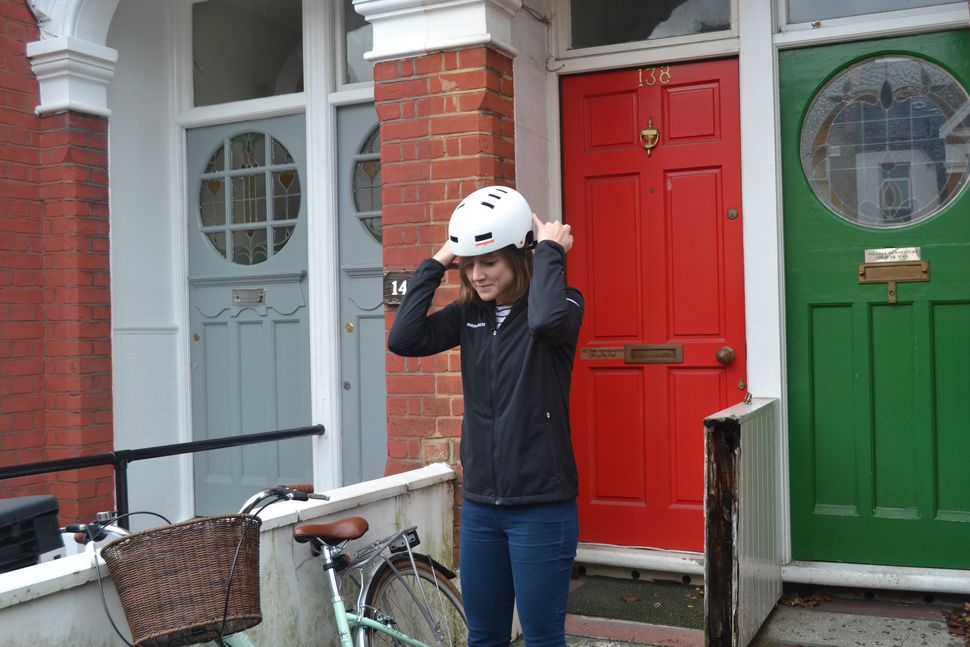I don’t love wearing a helmet.
Three years ago when my mum floated around the possibility of me having a bike in London, I couldn’t think of anything worse than having to wear one. They aren’t “cool”, I thought to myself. They give you hat hair. They don’t look good. They’re an effort to carry around. Were those reasons enough to put me off cycling at the time? Sadly, I think they were.
Now, as proud cyclist, I’d never set off on my bike without one.
This might be down to my parents’ strongly-worded advice after they bought me a brand-spanking new bike last year, or it could be because it makes me feel safer. I’m not entirely sure.

When it comes to the helmet debate - that is, should it be made compulsory to wear one by law? - I understand why the topic is sensitive and considered controversial. Helmets save lives, but they also deter people from getting out on the road. In November 2017, there were rumours cyclists could be made to wear helmets for the first time in a review of bike safety, said to be announced in the coming weeks.
Only in the past week, Malta reversed its law and made wearing helmets optional when riding below a certain speed limit. Transport Malta (TM) stated that the existing legislation forcing all cyclists to wear a helmet were believed to be “stifling efforts to promote the greater use of bicycles”.
Helmet laws across the world are far from universal. Australia and New Zealand require and enforce use of helmets by cyclists and in other countries, partial rules apply such as the use of helmets in certain areas. Then there’s Denmark and the Netherlands, countries which have such a strong cycling culture, yet the lowest levels of helmet use.
Back in 2016, a large-scale study covering 64,000 cycling accidents found that wearing helmets does reduce both death and injury. Researchers found that serious head injuries are reduced by almost 70% with a helmet. Another study, by Dr Jake Olivier of the university of New South Wales, found head injuries were 51% lower among cyclists who wore helmets and the risk of being killed is about one third as high for helmet wearers.
But the correlation between injuries and helmet use isn’t that simple. A study in November 2015 failed to find a link between helmet use and a reduction of head injuries. In fact, the academics discovered that riders who lived in areas with compulsory helmet laws were no more likely to seek medical help than those who were free to cycle without helmets. The authors were said to be “so surprised” by the results that they say they reran their models to check for human error.
A study in 2006 controversially found cyclists who wear helmets were more likely to be struck by passing vehicles. Dr Ian Walker, a traffic psychologist from the University of Bath used a bike fitted with a computer and a distance sensor to record data from over 2,500 overtaking motorists in Salisbury and Bristol.
He found that drivers were as much as twice as likely to get particularly close to the bike when the person was wearing the helmet. Drivers passed an average of 8.5 cm (3 1/3 inches) closer with the helmet than without.

Dr John Black works as a medical director of the South Central Ambulance Service and has seen many traumatic injuries caused by bicycle accidents. He is strongly in favour of the legislation and says just because there isn’t overwhelming evidence to say that helmets save lives, doesn’t mean wearing them isn’t beneficial. “Despite an increased uptake of helmets in recreational/commuting cyclists, far too many un-helmeted cyclists continue to be injured on our roads,” he says. “Head injury kills cyclists or causes devastating life-changing brain injury.”
These are also the views of Peter McCabe, chief executive of Headway – the brain injury association. “In the face of such overwhelming scientific evidence, medical expertise, and pure common sense, it is difficult to understand why some people would be opposed to moves to encourage their use,” he says. “Cycling is a fabulous way to keep fit and active. We are passionate about promoting safe cycling, including supporting calls for a range of additional measures to improve cyclists’ safety such as more dedicated cycle lanes, and educational campaigns aimed at both cyclists and motorists.
“But such measures can run alongside the promotion of helmets. It’s not an ‘either, or’ situation. Our message is simple: Get out there and get peddling, but please – use your head, use a helmet.”
Those against making helmets compulsory argue that it will reduce the number of people getting out on their bikes. Whether we like it or not, some people just don’t want to wear helmets for a range of reasons: hat hair, clunky, unattractive and uncomfortable. The British Medical Association argues making helmets compulsory would put so many cyclists off, that the resulting lack of exercise could even be more dangerous than the risk from head injuries.
“Where compulsory helmet laws have been introduced around the world we’ve typically seen a reduction in the number of people cycling of around 30%,” says Duncan Dollimore, head of campaigns at Cycling UK. “In Sydney, Australia the fall was as high as 90% for teenage girls, which would be a huge concern if replicated in the UK, where only one in five girls in that age group meet the government’s recommended physical activity targets and one in three year six pupils are obese or overweight.”
Dollimore, who believes in individual choice rather than being anti-helmet, argues fewer people cycling will lead to a less active population, potentially causing lives lost through lack of exercise and greater public health costs.
Studies aside, I can’t help but think that when it comes to cycling safety, the helmet debate seems to have dominated a conversation that overlooks what else needs to be done to ensure safety on the roads.
What about dedicated cycle lanes? Should we be focusing more on a road system that protects cyclists from the often unpredictable road traffic? More segregated bike lanes that protects cyclists from cars - like those you’ll see in the Netherlands - would make it not only safer, but also easier for cyclists to get out on the road. In November 2017, a survey of people in seven cities in the UK (Newcastle, Cardiff, Belfast, Bristol, Birmingham, Edinburgh and Greater Manchester) found that three quarters of people want more spending on cycle lanes in UK cities. Just 30% felt it was safe to cycle where they live, and many believed protected lanes would help. At the time, national and local governments were urged to work together “to invest and deliver segregated space for bikes and unlock the potential for cycling in every UK city.” It’s a big subject that I’ll be tackling in another column.
Whether helmets are made compulsory or not, I’ll always wear one.